Tomi Kinnunen
Investigating the Potential of Multi-Stage Score Fusion in Spoofing-Aware Speaker Verification
Sep 16, 2025Abstract:Despite improvements in automatic speaker verification (ASV), vulnerability against spoofing attacks remains a major concern. In this study, we investigate the integration of ASV and countermeasure (CM) subsystems into a modular spoof-aware speaker verification (SASV) framework. Unlike conventional single-stage score-level fusion methods, we explore the potential of a multi-stage approach that utilizes the ASV and CM systems in multiple stages. By leveraging ECAPA-TDNN (ASV) and AASIST (CM) subsystems, we consider support vector machine and logistic regression classifiers to achieve SASV. In the second stage, we integrate their outputs with the original score to revise fusion back-end classifiers. Additionally, we incorporate another auxiliary score from RawGAT (CM) to further enhance our SASV framework. Our approach yields an equal error rate (EER) of 1.30% on the evaluation dataset of the SASV2022 challenge, representing a 24% relative improvement over the baseline system.
Multilingual Source Tracing of Speech Deepfakes: A First Benchmark
Aug 06, 2025Abstract:Recent progress in generative AI has made it increasingly easy to create natural-sounding deepfake speech from just a few seconds of audio. While these tools support helpful applications, they also raise serious concerns by making it possible to generate convincing fake speech in many languages. Current research has largely focused on detecting fake speech, but little attention has been given to tracing the source models used to generate it. This paper introduces the first benchmark for multilingual speech deepfake source tracing, covering both mono- and cross-lingual scenarios. We comparatively investigate DSP- and SSL-based modeling; examine how SSL representations fine-tuned on different languages impact cross-lingual generalization performance; and evaluate generalization to unseen languages and speakers. Our findings offer the first comprehensive insights into the challenges of identifying speech generation models when training and inference languages differ. The dataset, protocol and code are available at https://github.com/xuanxixi/Multilingual-Source-Tracing.
FROST-EMA: Finnish and Russian Oral Speech Dataset of Electromagnetic Articulography Measurements with L1, L2 and Imitated L2 Accents
Jun 10, 2025Abstract:We introduce a new FROST-EMA (Finnish and Russian Oral Speech Dataset of Electromagnetic Articulography) corpus. It consists of 18 bilingual speakers, who produced speech in their native language (L1), second language (L2), and imitated L2 (fake foreign accent). The new corpus enables research into language variability from phonetic and technological points of view. Accordingly, we include two preliminary case studies to demonstrate both perspectives. The first case study explores the impact of L2 and imitated L2 on the performance of an automatic speaker verification system, while the second illustrates the articulatory patterns of one speaker in L1, L2, and a fake accent.
STOPA: A Database of Systematic VariaTion Of DeePfake Audio for Open-Set Source Tracing and Attribution
May 26, 2025Abstract:A key research area in deepfake speech detection is source tracing - determining the origin of synthesised utterances. The approaches may involve identifying the acoustic model (AM), vocoder model (VM), or other generation-specific parameters. However, progress is limited by the lack of a dedicated, systematically curated dataset. To address this, we introduce STOPA, a systematically varied and metadata-rich dataset for deepfake speech source tracing, covering 8 AMs, 6 VMs, and diverse parameter settings across 700k samples from 13 distinct synthesisers. Unlike existing datasets, which often feature limited variation or sparse metadata, STOPA provides a systematically controlled framework covering a broader range of generative factors, such as the choice of the vocoder model, acoustic model, or pretrained weights, ensuring higher attribution reliability. This control improves attribution accuracy, aiding forensic analysis, deepfake detection, and generative model transparency.
Continuous Learning for Children's ASR: Overcoming Catastrophic Forgetting with Elastic Weight Consolidation and Synaptic Intelligence
May 26, 2025Abstract:In this work, we present the first study addressing automatic speech recognition (ASR) for children in an online learning setting. This is particularly important for both child-centric applications and the privacy protection of minors, where training models with sequentially arriving data is critical. The conventional approach of model fine-tuning often suffers from catastrophic forgetting. To tackle this issue, we explore two established techniques: elastic weight consolidation (EWC) and synaptic intelligence (SI). Using a custom protocol on the MyST corpus, tailored to the online learning setting, we achieve relative word error rate (WER) reductions of 5.21% with EWC and 4.36% with SI, compared to the fine-tuning baseline.
ASVspoof 5: Design, Collection and Validation of Resources for Spoofing, Deepfake, and Adversarial Attack Detection Using Crowdsourced Speech
Feb 13, 2025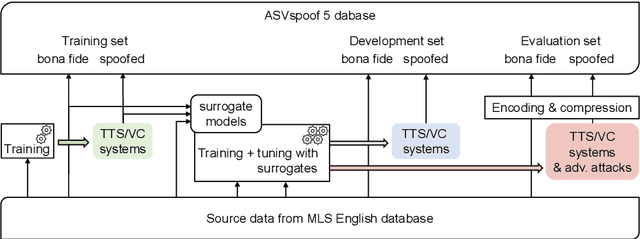

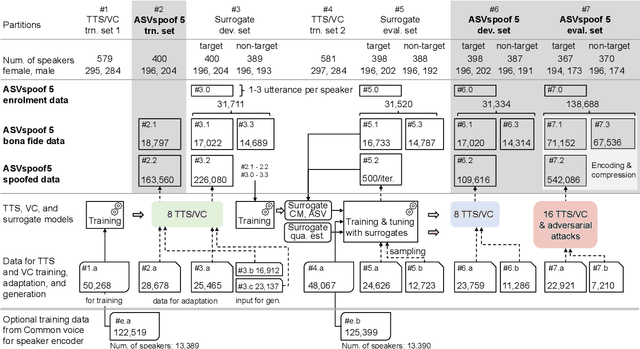
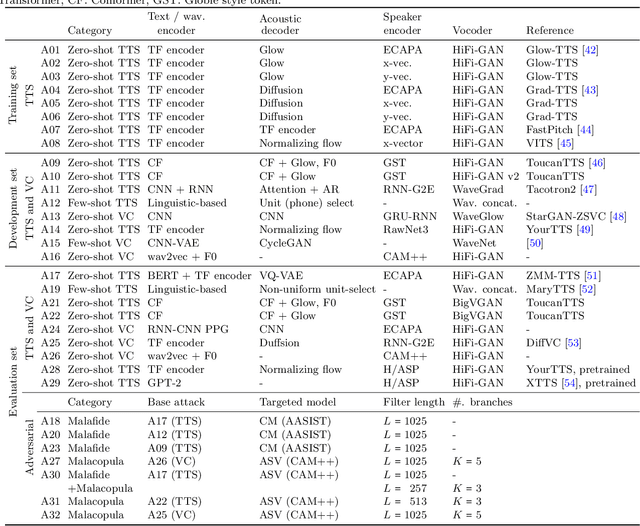
Abstract:ASVspoof 5 is the fifth edition in a series of challenges which promote the study of speech spoofing and deepfake attacks as well as the design of detection solutions. We introduce the ASVspoof 5 database which is generated in crowdsourced fashion from data collected in diverse acoustic conditions (cf. studio-quality data for earlier ASVspoof databases) and from ~2,000 speakers (cf. ~100 earlier). The database contains attacks generated with 32 different algorithms, also crowdsourced, and optimised to varying degrees using new surrogate detection models. Among them are attacks generated with a mix of legacy and contemporary text-to-speech synthesis and voice conversion models, in addition to adversarial attacks which are incorporated for the first time. ASVspoof 5 protocols comprise seven speaker-disjoint partitions. They include two distinct partitions for the training of different sets of attack models, two more for the development and evaluation of surrogate detection models, and then three additional partitions which comprise the ASVspoof 5 training, development and evaluation sets. An auxiliary set of data collected from an additional 30k speakers can also be used to train speaker encoders for the implementation of attack algorithms. Also described herein is an experimental validation of the new ASVspoof 5 database using a set of automatic speaker verification and spoof/deepfake baseline detectors. With the exception of protocols and tools for the generation of spoofed/deepfake speech, the resources described in this paper, already used by participants of the ASVspoof 5 challenge in 2024, are now all freely available to the community.
Causal Analysis of ASR Errors for Children: Quantifying the Impact of Physiological, Cognitive, and Extrinsic Factors
Feb 12, 2025Abstract:The increasing use of children's automatic speech recognition (ASR) systems has spurred research efforts to improve the accuracy of models designed for children's speech in recent years. The current approach utilizes either open-source speech foundation models (SFMs) directly or fine-tuning them with children's speech data. These SFMs, whether open-source or fine-tuned for children, often exhibit higher word error rates (WERs) compared to adult speech. However, there is a lack of systemic analysis of the cause of this degraded performance of SFMs. Understanding and addressing the reasons behind this performance disparity is crucial for improving the accuracy of SFMs for children's speech. Our study addresses this gap by investigating the causes of accuracy degradation and the primary contributors to WER in children's speech. In the first part of the study, we conduct a comprehensive benchmarking study on two self-supervised SFMs (Wav2Vec2.0 and Hubert) and two weakly supervised SFMs (Whisper and MMS) across various age groups on two children speech corpora, establishing the raw data for the causal inference analysis in the second part. In the second part of the study, we analyze the impact of physiological factors (age, gender), cognitive factors (pronunciation ability), and external factors (vocabulary difficulty, background noise, and word count) on SFM accuracy in children's speech using causal inference. The results indicate that physiology (age) and particular external factor (number of words in audio) have the highest impact on accuracy, followed by background noise and pronunciation ability. Fine-tuning SFMs on children's speech reduces sensitivity to physiological and cognitive factors, while sensitivity to the number of words in audio persists. Keywords: Children's ASR, Speech Foundational Models, Causal Inference, Physiology, Cognition, Pronunciation
Meta-Learning Approaches for Improving Detection of Unseen Speech Deepfakes
Oct 27, 2024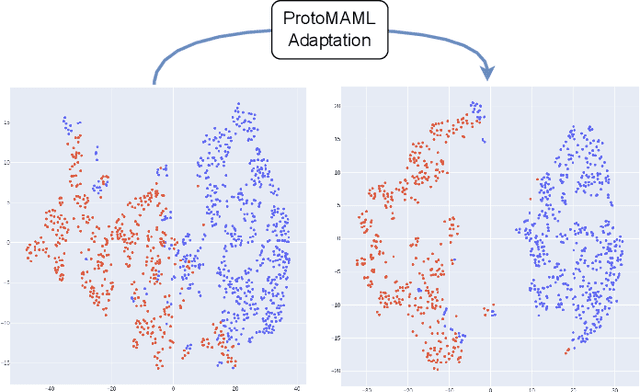


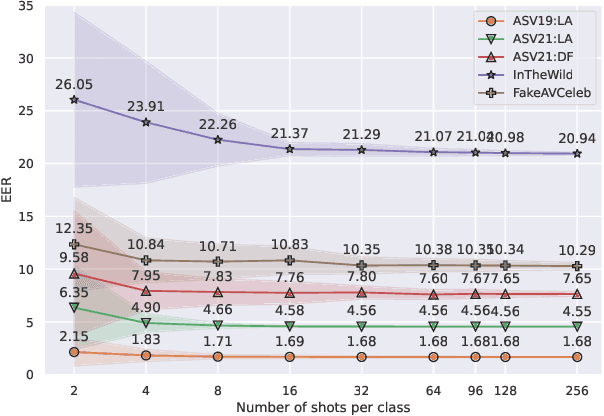
Abstract:Current speech deepfake detection approaches perform satisfactorily against known adversaries; however, generalization to unseen attacks remains an open challenge. The proliferation of speech deepfakes on social media underscores the need for systems that can generalize to unseen attacks not observed during training. We address this problem from the perspective of meta-learning, aiming to learn attack-invariant features to adapt to unseen attacks with very few samples available. This approach is promising since generating of a high-scale training dataset is often expensive or infeasible. Our experiments demonstrated an improvement in the Equal Error Rate (EER) from 21.67% to 10.42% on the InTheWild dataset, using just 96 samples from the unseen dataset. Continuous few-shot adaptation ensures that the system remains up-to-date.
ASVspoof 5: Crowdsourced Speech Data, Deepfakes, and Adversarial Attacks at Scale
Aug 16, 2024



Abstract:ASVspoof 5 is the fifth edition in a series of challenges that promote the study of speech spoofing and deepfake attacks, and the design of detection solutions. Compared to previous challenges, the ASVspoof 5 database is built from crowdsourced data collected from a vastly greater number of speakers in diverse acoustic conditions. Attacks, also crowdsourced, are generated and tested using surrogate detection models, while adversarial attacks are incorporated for the first time. New metrics support the evaluation of spoofing-robust automatic speaker verification (SASV) as well as stand-alone detection solutions, i.e., countermeasures without ASV. We describe the two challenge tracks, the new database, the evaluation metrics, baselines, and the evaluation platform, and present a summary of the results. Attacks significantly compromise the baseline systems, while submissions bring substantial improvements.
Beyond Silence: Bias Analysis through Loss and Asymmetric Approach in Audio Anti-Spoofing
Jun 25, 2024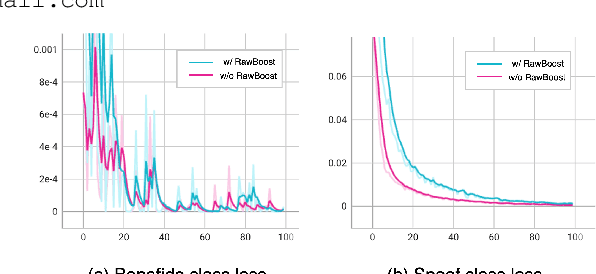

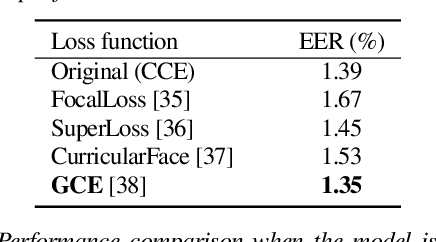
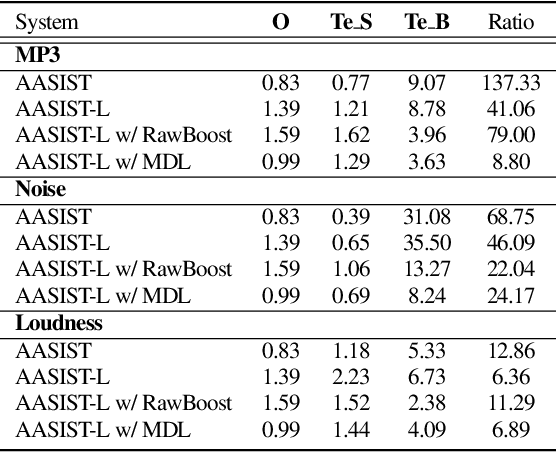
Abstract:Current trends in audio anti-spoofing detection research strive to improve models' ability to generalize across unseen attacks by learning to identify a variety of spoofing artifacts. This emphasis has primarily focused on the spoof class. Recently, several studies have noted that the distribution of silence differs between the two classes, which can serve as a shortcut. In this paper, we extend class-wise interpretations beyond silence. We employ loss analysis and asymmetric methodologies to move away from traditional attack-focused and result-oriented evaluations towards a deeper examination of model behaviors. Our investigations highlight the significant differences in training dynamics between the two classes, emphasizing the need for future research to focus on robust modeling of the bonafide class.
 Add to Chrome
Add to Chrome Add to Firefox
Add to Firefox Add to Edge
Add to Edge